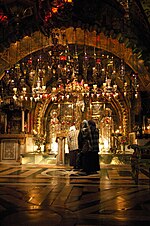Church of the Redeemer, Jerusalem

The Lutheran Church of the Redeemer (Hebrew: כנסיית הגואל, Arabic: الكنيسة اللوثرية في القدس, German: Erlöserkirche) is the second Protestant church in Jerusalem (the first being Christ Church near Jaffa Gate). It is a property of the Evangelical Jerusalem Foundation, one of the three foundations of the Evangelical Church in Germany (EKD) in the Holy Land. Built between 1893 and 1898 by the architect Paul Ferdinand Groth following the designs of Friedrich Adler, the Church of the Redeemer currently houses Lutheran congregations that worship in Arabic, German, Danish, and English. The Church, together with the adjoining provost building, is the seat of the Provost of the German Protestant Ministries in the Holy Land ("Evangelisch in Jerusalem"). It also serves as the headquarters of the Bishop of the Evangelical Lutheran Church in Jordan and the Holy Land, since this Arabic-speaking (Palestinian) church became independent from the German provost in 1979.Built on land given to King William I of Prussia (after 1870 Kaiser Wilhelm I) on the occasion of the latter's participation at the inauguration of the Suez Canal in 1869 by Sultan Abdülhamid of the Ottoman Empire, the church was constructed from 1892 to 1898. The location had been the site of the old church of St. Mary Minor. In 1898, Kaiser Wilhelm II made a trip to Jerusalem to personally dedicate the new church. For the dedication of the church, the Kaiser entered the city on horse back through two specially made ceremonial arches, one a gift of the Ottoman Empire and one a gift from the local Jewish community. The church was dedicated on Reformation Day, 1898. At the dedication, Wilhelm said: From Jerusalem came the light in splendor from which the German nation became great and glorious; and what the Germanic peoples have become, they became under the banner of the cross, the emblem of self-sacrificing charity. Redeemer Church was closed for services from the end of May 1940 until 1950, when first the Palestinian Lutheran congregation resumed services, and later the Evangelical congregation of German language followed.In the garden next to the church is a memorial marking the location of the crusader headquarters of the Order of the Knights of St. John.
Excerpt from the Wikipedia article Church of the Redeemer, Jerusalem (License: CC BY-SA 3.0, Authors, Images).Church of the Redeemer, Jerusalem
Heil HaHandasa, Jerusalem Morasha
Geographical coordinates (GPS) Address Nearby Places Show on map
Geographical coordinates (GPS)
| Latitude | Longitude |
|---|---|
| N 31.777777777778 ° | E 35.230555555556 ° |
Address
העיר העתיקה בירושלים וחומותיה
Heil HaHandasa
9511208 Jerusalem, Morasha
Jerusalem District, Israel
Open on Google Maps









